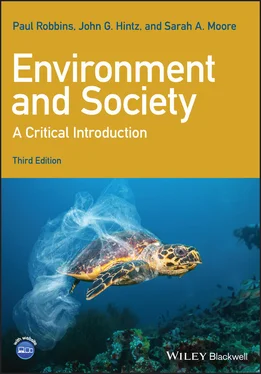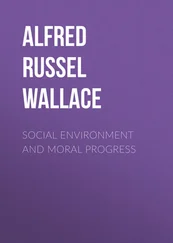If, on the other hand, the family came first or it held some kind of county-given right to a non-smelly environment, other options emerge. In that case, the cattle owner might cease ranching, at whatever cost, and sell to a housing developer. It may be even cheaper for the rancher to directly pay the homeowners, essentially bribing them to put up with it. On the other hand, if it turns out to be even less expensive to move the cattle shed than it is to pay off the neighbors, the rancher can always choose this option.
Notably, it does not matter what the configuration of legal rights is at the outset of the scenario – ranchers might hold the right to ranch, families might have the right to be free of cattle smells, or neither may pertain. In any case, if contracts can be worked out and enforced between the two parties, they always reach a decision that is economically most efficient. Such a determination is fully in line with the market response model, but extends its crystalline logics to the complex world of environmental externalities.
ExternalityThe spillover of a cost or benefit, as where industrial activity at a plant leads to pollution off-site that must be paid for by someone else
Coase stipulated two key assumptions, however, that were required to be true for such smooth efficiencies to prevail: property rights have to be exclusive and the transfer and protection of contracted rights has to be free. This means, for the efficiencies of Coase to be realized in the above example, 1) both the rancher and the homeowner must have the full ability to control their land and the decisions made on it and, more importantly, 2) their negotiations and contracts must not cost time or money to negotiate, write, and enforce. Put in other terms, a free market system is efficient to the degree that actually sorting out agreements, coming to understandings, and designing fair rules and restrictions are socially and economically free or cheap. Similarly, it depends on enforcement (policing, monitoring, and punishing violations) of contracts and rights having no costs.
And in reality, of course, this is totally untrue. For our rancher and homeowner, the time it takes to negotiate the contract, the possible cost in lawyers, and the hidden cost of maintaining county court houses and civil servants to process and administer the contract are indeed quite high. Defining property rights for more intangible goods and services (e.g. biodiversity) is even more daunting. Enforcing contracts over incredibly complex systems (e.g. global climate) appears all the more impossible. The problem comes in the practical difficulty of assigning private rights to “fugitive,” mobile, intangible things – like air – clearly contracting the relations between owners, and enforcing the results. For an “air market” to function, the air must be owned by someone who paid for it, who can get value from it, who has an individual interest in keeping it clean, and who can legally challenge someone else who dirties it or violates a contractual agreement over its condition.
While in some ways such a market seems inconceivable (because it is difficult to enclose, see Chapter 4), recent evidence suggests that it may be possible. Rather than assigning rights to clean air, recent efforts in the United States and elsewhere have worked to give rights to pollute . In a specific example, in the early 1990s, the United States Environmental Protection Agency (EPA) set limits on industries for the emission of sulfur dioxide, a primary cause of acid rain. But rather than setting a limit on each factory, the total allowable level of pollution was divided into units and distributed to producers, in the form of credits that could be sold. Should a company find a cheap way to reduce their sulfur dioxide production below the level for which they held credits, they could sell the spare credits for a profit. More radically, if environmental groups believe that the limit on total emissions provided in the credit system is too high, and they are willing to pay to reduce it, they have the right to buy credits on the market, like anyone else, and simply take them out of circulation. This also has the effect of raising the scarcity and cost of pollution credits, creating incentives for industry to become even more efficient. Such a market has been in operation for 15 years and is only one of many such efforts (see more on “cap and trade” later in this chapter).
Whatever the flaws in such a system, it demonstrates that markets can function for all sorts of environmental goods and services, but that – as Coase suggests – to make them work, private property rights to nature must be clearly assigned to corporations or people. This is a logical and practical prerequisite to any market solution, but certainly one with serious social, environmental, and political implications, as we shall see.
There are several ways in which these market and contract-governed ways of living in nature might fail. Such market failuresemerge from a mismatch between the assumptions of the market model and the real world. Chief challenges to market assumptions include the facts that 1) transactions are not by any means free (as per Coase’s assumptions), 2) contracts and property rights have to be defined and enforced often at great legal and regulatory expense, and 3) not all parties to negotiations have perfect and equal information. This is especially the case for environmental goods and services that are spread across a large population of individuals.
Market FailureA situation or condition where the production or exchange of a good or service is not efficient; this refers to a range of perverse economic outcomes stemming from market problems like monopoly or uncontrolled externalities
Transaction CostsIn economics, the cost associated with making an exchange, including, for example, drawing a contract, traveling to market, or negotiating a price; while most economic models assume low transaction costs, in reality these costs can be quite high, especially for systems with high externalities
Consider, for example, the problem of the ranch and residence provided earlier, but now imagine it with thousands of scattered homeowners and hundreds of ranches. Under such circumstances, the complexity of working out discrete contracted negotiations becomes enormous, as does the problem of monitoring and enforcing the rights of different ranchers each operating with different rules with differing property owners.
There is also always a temptation for some people to wait to accrue benefits from other people’s negotiations without taking the time or energy to negotiate for themselves. Such a “free-rider” problem is typical of common property environmental problems (see Chapter 4). In such a case, the transaction costsof getting the problem sorted out contractually are simply much higher than the cost of the problem. Typically such cases lend themselves to regulatory and treaty-based, rather than market-based, solutions. For example, the system of tradable pollution credits that made acid rain reduction a success in the United States had to be created and enforced by the Environmental Protection Agency of that country, an entity with police powers paid for through federal taxation. Consider too, that reduction of sulfur emissions in Europe was managed through the creation of the “Helsinki Protocol,” a treaty agreement to achieve 30% reductions by 21 nations signing the document. Efficient markets require public investments. Free markets are rarely free.
MonopolyA market condition where there is one seller for many buyers, leading to perverted and artificially inflated pricing of goods or services
Читать дальше











